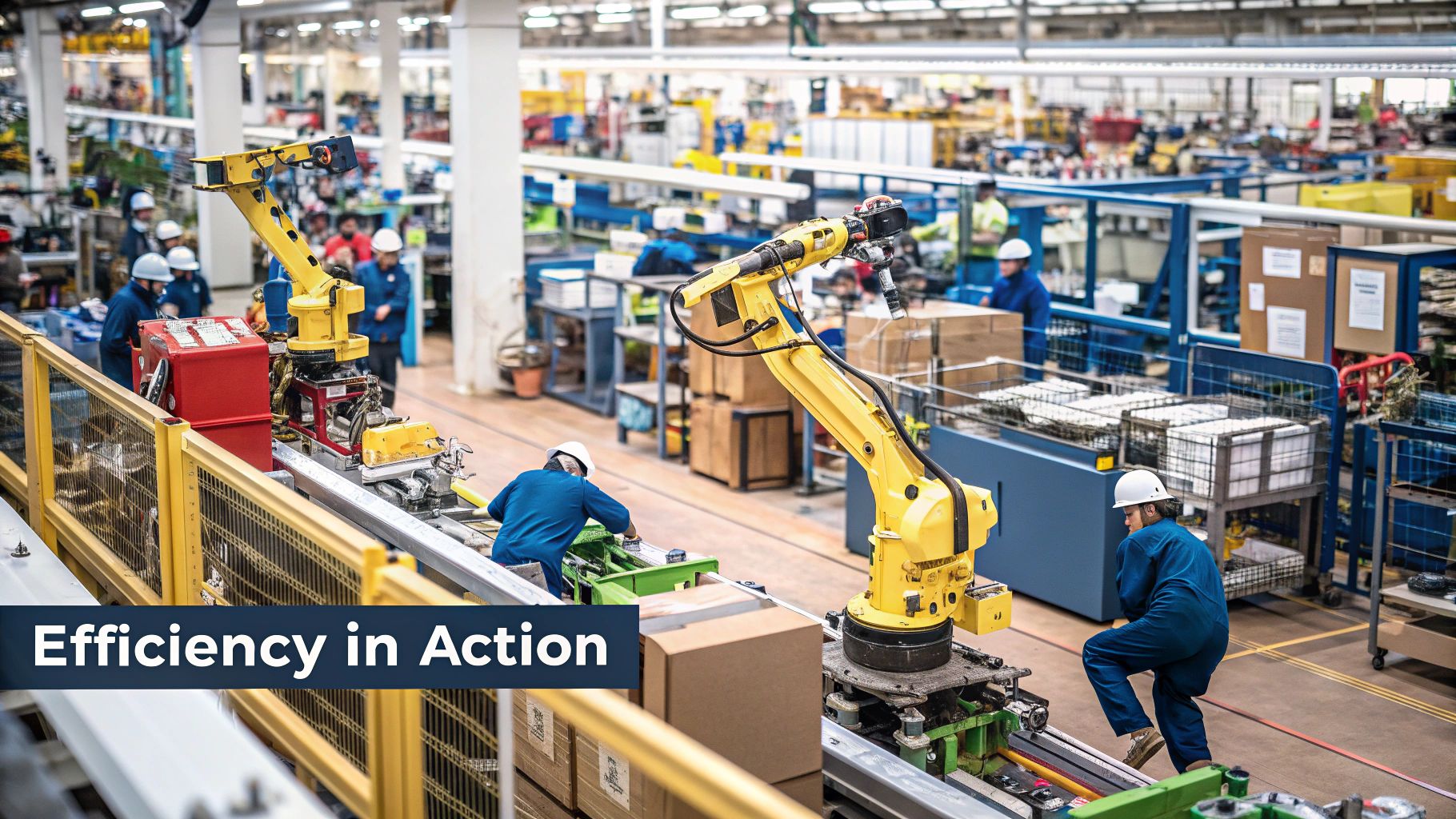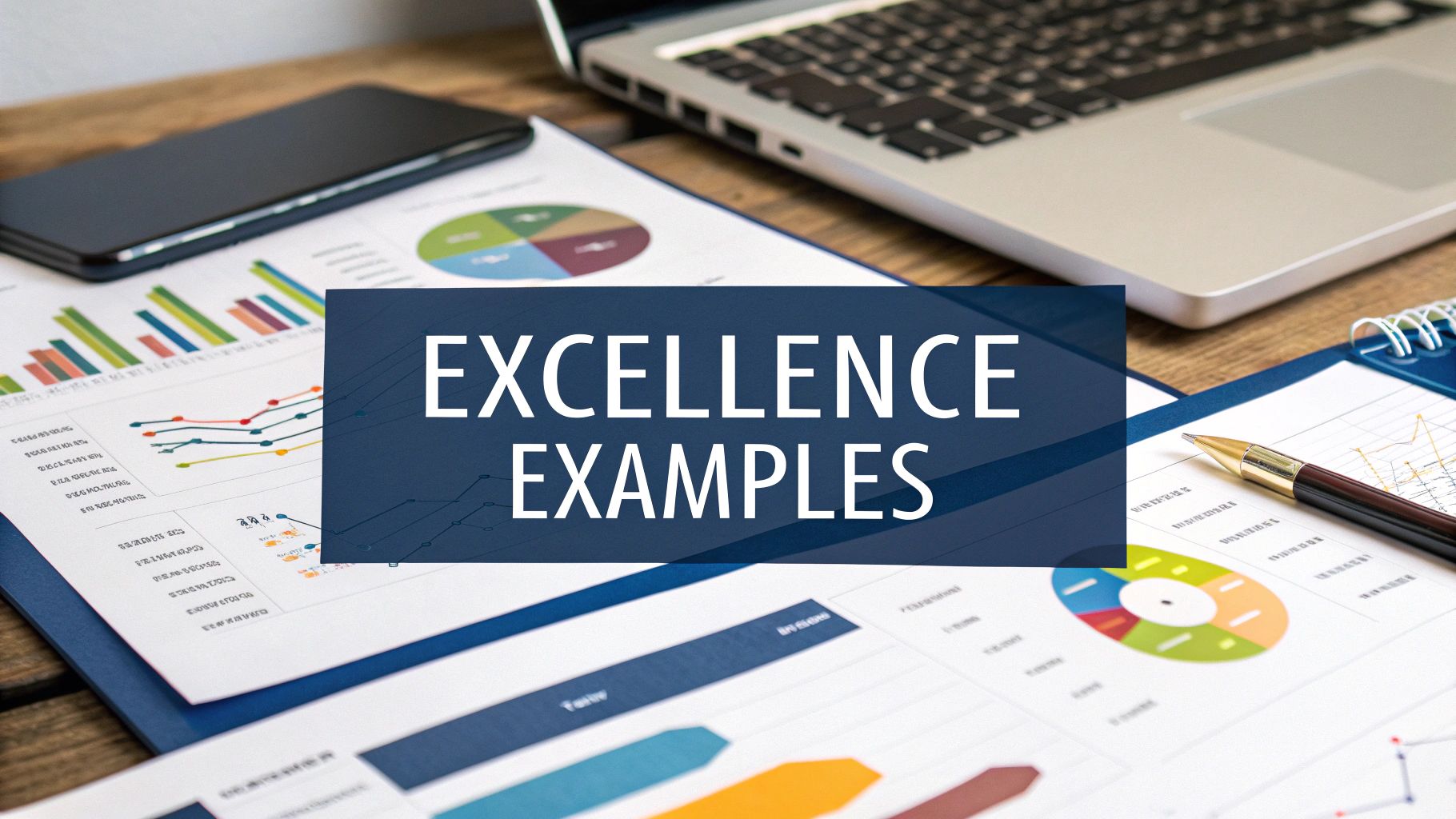Practical Guide to Organizational Excellence

Real success in business comes from blending solid methods with meaningful cultural shifts. When companies get this mix right, they see remarkable improvements in how they work and what they achieve. Let's look at some real examples of how this plays out.
Core Components That Drive Results
The most effective approaches to organizational excellence focus on these essential elements:
- Customer First: Making decisions based on what customers actually need and want. This means actively gathering feedback and using those insights to make products and services better.
- Employee Voice: Getting team members involved in spotting and fixing problems. When staff feel heard and valued, they bring more ideas and energy to their work.
- Never-Ending Improvement: Making small, steady upgrades over time rather than big changes all at once. This keeps the company moving forward and adapting.
- Facts Over Feelings: Using real numbers and data to guide choices. This helps teams focus on what actually works, not just what seems like it might work.
Real-World Success Stories
Companies across different industries have put these ideas into practice with impressive results. Take Motorola - they created Six Sigma to tackle quality issues by finding and fixing the root causes of problems in their manufacturing. This led to better products and happier customers.
Dell made waves in the 1990s by completely rethinking how they sold computers. They let customers order directly through their website, cutting costs and speeding up delivery. This new approach showed how focusing on customer needs can reshape an entire business model.
At GE, former CEO Jack Welch made quality improvement part of everyone's job. The company tied promotions to Six Sigma training and created their own problem-solving method called GE Workout. This showed how making improvement part of company culture can drive lasting change.
Even simpler tools can make a big difference. Music streaming company Spotify uses Kanban boards to keep track of projects and spot slowdowns before they become problems. This visual system helps creative teams stay organized without getting bogged down in bureaucracy.
These examples show how different methods can work in various settings to boost quality, speed things up, and make customers happier. The key is picking an approach that fits your company's specific needs and goals.
Inside Toyota's Legendary Kaizen Culture

Toyota's remarkable journey to manufacturing excellence hinges on one powerful concept: Kaizen. This Japanese term for "continuous improvement" shapes how every person at Toyota approaches their work each day. But what makes their implementation of Kaizen so uniquely effective? Let's examine the key elements that drive Toyota's culture of never-ending progress.
Employee Engagement and Bottom-Up Improvement
At Toyota, improvements flow from the ground up. Assembly line workers, engineers, and managers all actively spot opportunities to make processes better. This approach gives everyone ownership over their work and recognizes that good ideas can come from anywhere. Small wins matter here - even tiny efficiency gains receive recognition and praise.
The power of this inclusive mindset shows in the results. For example, when a production line employee noticed they could save 3 seconds per car by slightly adjusting their workflow, that small change added up to major time and cost savings across thousands of vehicles. By tapping into the expertise of their entire workforce, Toyota creates an engine of constant optimization driven by those closest to the actual work.
Systematic Problem-Solving and Leadership Development
Toyota pairs employee engagement with structured methods for analyzing and fixing issues. Rather than jumping to quick fixes, teams dig deep to find and address root causes. Leaders play a crucial role here - they receive extensive training in coaching others to solve problems effectively.
This investment in leadership ensures the improvement mindset stays strong throughout the company. Managers don't just give orders - they teach their teams how to spot issues and develop solutions. The result is a self-sustaining cycle where engaged employees and skilled leaders work together to make processes better every day.
Measurable Impacts and Real-World Examples
The proof of Toyota's Kaizen success shows up clearly in the numbers. Their plants consistently achieve lower defect rates, less waste, and higher customer satisfaction scores. Engineering teams streamline designs more effectively. Production costs keep falling while quality rises.
These concrete wins demonstrate how a culture focused on small, steady improvements can transform an organization. By making Kaizen central to how they operate, Toyota has built a system that delivers excellence day after day. Learn more about operational excellence in action here.
Digital Transformation in Mining Operations
Mining companies are actively adopting digital technologies to improve their operations. Smart tech integration helps mining operations run more efficiently and safely. The shift goes beyond just buying new equipment - it requires careful planning and implementation across the entire organization.
Using Data Analytics for Better Decisions
Modern mining generates huge amounts of operational data that can drive major improvements. Smart sensors track equipment performance in real-time, helping prevent breakdowns before they happen. Analysis of geological data helps mining teams optimize where and how to extract resources. For instance, monitoring drill performance data can indicate when maintenance is needed, avoiding costly equipment failures. This data-driven approach leads to less waste and better results.
Remote Operations and Process Improvements
Remote monitoring systems are changing how mining sites operate, especially for companies with widespread locations. Teams can now track and control equipment from central offices, responding faster to issues while keeping workers away from dangerous areas. This remote capability also makes it easier to standardize processes across different sites. Regular tasks can be automated, communication improves, and overall efficiency increases.
A real success story comes from a major mining company that went beyond expectations. Though experts predicted only a 7% possible output increase at their best-performing site, the company achieved a 25% boost in the first year through smart tech use. After three years, output was up 40% - without spending extra on equipment. The company's investment in remote monitoring proved especially valuable during COVID-19 restrictions. Learn more about their approach here.
Building Team Skills for Long-term Success
Getting the full benefit of digital tools requires developing the right team capabilities. Companies need to train workers to use new technologies effectively. Creating a workplace culture that welcomes new ideas helps employees suggest and implement digital solutions. This approach ensures improvements last and build on each other over time, rather than being temporary fixes.
Healthcare Excellence: UHN's Digital Revolution

The University Health Network (UHN) shows how large healthcare organizations can successfully improve patient care through thoughtful technology adoption. By focusing on both their processes and their people, UHN created meaningful changes that made a real difference for patients and staff alike.
Balancing Technology and Patient Care
When UHN began updating their systems, they put patients first. Rather than chasing the latest tech trends, they carefully chose tools that would solve specific problems their patients and staff faced every day. This meant working closely with doctors and nurses to understand their needs, then measuring how each change affected patient outcomes. The result? Better care that actually made sense for everyone involved.
Streamlining Processes for Enhanced Efficiency
One of UHN's biggest wins came from fixing their patient discharge process. Before the changes, getting discharge paperwork to the right people often took too long, which affected follow-up care. By rethinking how they handled these crucial documents, they didn't just speed things up - they made sure the information reached everyone who needed it, when they needed it.
The results speak for themselves. After making these changes, UHN saw discharge summaries completed on time jump by 70%, while getting those summaries to other healthcare providers improved by 120%. These improvements came from smart process changes combined with the right technology tools. Learn more about their journey here.
Empowering People for Lasting Change
UHN knew that even the best technology only works when people know how to use it well. They invested heavily in training their staff, making sure everyone felt comfortable with the new tools and processes. This focus on people helped make the improvements stick - instead of temporary fixes, they created lasting positive change. By supporting both their processes and their people, UHN showed how healthcare organizations can make meaningful progress that benefits everyone involved.
Building Your Operational Excellence Roadmap

Creating real operational excellence takes more than good intentions - it requires careful planning and execution. Let's explore how successful organizations build and implement their improvement initiatives, while avoiding common pitfalls that can derail progress.
Assessing Your Current State
The first step is taking an honest look at where you stand today. Get specific data about your processes, performance metrics, and how your teams actually work. Look for concrete problems to fix - like a manufacturing plant examining their actual defect rates, production speeds, and inventory levels. These measurements give you a clear starting point to track improvements.
Defining Your Vision and Objectives
With baseline data in hand, outline exactly what success looks like. Set specific, measurable goals that connect directly to your business priorities. For example, aiming to cut production costs by 15% and reduce defects by 10% within 12 months. When everyone understands the targets, they can align their daily work accordingly.
Developing a Phased Implementation Plan
Big changes work best in manageable steps. Start with a focused pilot project to test your approach and learn what works. Once you've shown success in one area, methodically expand to other parts of the organization. This measured rollout helps you refine methods while limiting disruption to the business.
Building Effective Governance Structures
Clear oversight keeps improvement efforts on track. Assign specific people to lead initiatives and hold regular check-ins on progress. A dedicated steering team can provide guidance, remove obstacles, and ensure accountability. Without this structure, even promising projects often lose momentum.
Developing Internal Capabilities
Your people need the right skills to drive lasting improvement. Invest in practical training on problem-solving methods, process analysis, and using data effectively. Tools like Lean Six Sigma give teams concrete ways to spot and fix inefficiencies. When employees feel equipped to solve problems, they take more ownership of improvements.
Creating a Sustainable Improvement Engine
The goal is making excellence part of your culture, not just a one-time project. Set up regular forums to review progress, share learnings, and plan next steps. Recognize and celebrate wins to reinforce the right behaviors. Consider weekly team huddles to discuss challenges and brainstorm solutions. These habits help embed continuous improvement into how work gets done.
Measuring Success and Sustaining Momentum
Success in operational excellence comes from tracking your progress and keeping teams engaged over time. This means choosing the right metrics, collecting meaningful data, and using feedback to drive ongoing improvements.
Designing Effective Measurement Systems
A good measurement system helps you see if your initiatives are working. Start by clearly defining what you want to accomplish - whether that's fewer defects, happier customers, or faster processes. Then pick Key Performance Indicators (KPIs) that show progress toward those goals. For example, if you aim to improve customer satisfaction, you might track your Net Promoter Score (NPS).
But numbers alone aren't enough. You need a reliable way to gather and analyze the data behind those KPIs. This could mean setting up automatic data tracking, sending out regular surveys, or building performance dashboards. The insights from this data help teams make better decisions and spot areas to improve.
Selecting Meaningful KPIs
Choose KPIs that connect directly to your business goals. A factory might focus on defect rates and production times, while a service company could track customer wait times and issue resolution rates. The best KPIs are both easy to measure and help drive action. Keep your KPI list short to stay focused on what matters most.
For instance, if reducing waste is your goal, you might track the percentage of materials recycled and waste sent to landfills. These specific numbers clearly show if you're meeting waste reduction targets.
Creating Feedback Loops That Drive Continuous Improvement
Good feedback loops connect performance data back to the teams doing the work. Share results openly and make time to discuss them. Regular check-ins, team meetings, and project reviews give people chances to look at the data, find the root causes of problems, and work on solutions.
This cycle of feedback and improvement keeps momentum going. If customer complaints suddenly increase, teams can quickly look at the data, figure out why, and fix the issue before it gets worse.
Maintaining Stakeholder Buy-in and Celebrating Wins
Keep everyone engaged - from front-line staff to executives - by sharing progress updates and showing results. Point out both big and small wins through team recognition, company announcements, or personal thank-yous. This builds a culture where people want to keep improving.
Stay flexible and adjust your approach based on what the data tells you. If something isn't working as planned, be ready to try new solutions. This willingness to evolve helps organizations succeed as conditions change.
Are you ready to break free from conventional thinking and explore a path to true freedom? The Covered Call Podcast, hosted by Jason Nutter and Lovis Kauf, delves into the stories, strategies, and mindsets of those who have achieved success through entrepreneurship, smart investments, and unconventional opportunities. Join us as we explore insights from guests like Luke Gromen, Rick Rule, and Doug Casey, who share their journeys to personal and financial liberty. Tune in to The Covered Call Podcast today and begin your journey toward a more fulfilling and impactful life: The Covered Call Podcast

